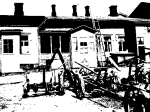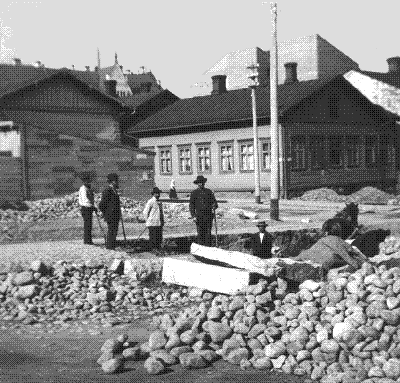Get Lost in Hyperspace
 Get lost... was a commissioned work for 1992 Tampere biennale of contemporary music. Due to a hard disk crash the work transcended into hyperspace, only few images and notes remained salvaged. (Like the stuff below...)
Get lost... was a commissioned work for 1992 Tampere biennale of contemporary music. Due to a hard disk crash the work transcended into hyperspace, only few images and notes remained salvaged. (Like the stuff below...)
 It is easy to agree to the definition of a work of art as something greater than the sum of its parts - a holistic appearance. Even the observer adds to his perceptions with his mental imagery. Mental images are intimate by nature and vary in time. In general terms we can describe the work-public relationship as an expanding set of these images. Hypermedia-art explores these holistic structures through combining voice, sound, text and images, both still and moving. Through interactivity artists seek to introduce and increase experiences and offer the explorer a possibility to experience artistic pleasure and gain insights.
It is easy to agree to the definition of a work of art as something greater than the sum of its parts - a holistic appearance. Even the observer adds to his perceptions with his mental imagery. Mental images are intimate by nature and vary in time. In general terms we can describe the work-public relationship as an expanding set of these images. Hypermedia-art explores these holistic structures through combining voice, sound, text and images, both still and moving. Through interactivity artists seek to introduce and increase experiences and offer the explorer a possibility to experience artistic pleasure and gain insights.

 Jean Piaget claims that the society accepts new technologies - means and their uses - through assimilating then into old ones. Early cinema was steadfast committed to drama and literary tradition. TV started as a household cinema. True expression and possibilities of the new technologies remain hidden because we understand them as improvements to the old ones.
Jean Piaget claims that the society accepts new technologies - means and their uses - through assimilating then into old ones. Early cinema was steadfast committed to drama and literary tradition. TV started as a household cinema. True expression and possibilities of the new technologies remain hidden because we understand them as improvements to the old ones.
 This has largely been the case with computers as well, by and large they are the faster calculators and more efficient writing machines - in sickness and health. Because of this we today, as computers and consumer electronics are rapidly integrating, sometimes find hard to reach through visions of possibilities to technical innovations, new approaches to old problems and last but not least to the new genres of artistic expression. Yet art offers an ideal forum to explore and stretch the traditional, the accepted and the assimilating.
This has largely been the case with computers as well, by and large they are the faster calculators and more efficient writing machines - in sickness and health. Because of this we today, as computers and consumer electronics are rapidly integrating, sometimes find hard to reach through visions of possibilities to technical innovations, new approaches to old problems and last but not least to the new genres of artistic expression. Yet art offers an ideal forum to explore and stretch the traditional, the accepted and the assimilating.

 The grand old men of hypertext: Vannevar Bush, Doug Engelbart and Ted Nelson, saw it easier to control and manipulate large quantities of information of varied types, provided the information was associatively organized and accessing it was rapid and flexible. Merits of the associatively linked information were readily admitted in design and other creative and collaborative work. At first glance the model feels feasible and fit to human thinking - after all we tend to organize our perceptions of the outside world into webs of associations. It was clear from the first experiments on that the multitude of interlinked pieces of varied types of information - the hyperspace - appeared as vast and formless. Getting lost in Hyperspace became the dread and horror of almost every hypertext author and explorer. This work is a conscious plunge into a web of associations of pictures, animations and videoclips. I want to encourage you to get lost and come back.
The grand old men of hypertext: Vannevar Bush, Doug Engelbart and Ted Nelson, saw it easier to control and manipulate large quantities of information of varied types, provided the information was associatively organized and accessing it was rapid and flexible. Merits of the associatively linked information were readily admitted in design and other creative and collaborative work. At first glance the model feels feasible and fit to human thinking - after all we tend to organize our perceptions of the outside world into webs of associations. It was clear from the first experiments on that the multitude of interlinked pieces of varied types of information - the hyperspace - appeared as vast and formless. Getting lost in Hyperspace became the dread and horror of almost every hypertext author and explorer. This work is a conscious plunge into a web of associations of pictures, animations and videoclips. I want to encourage you to get lost and come back.